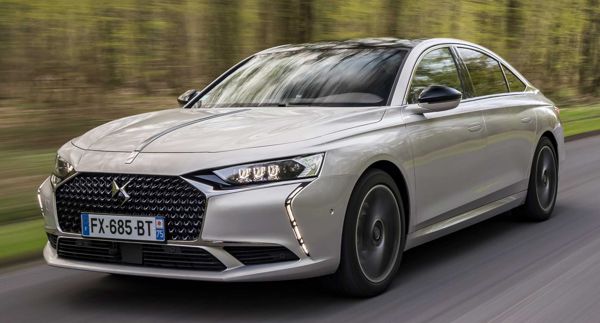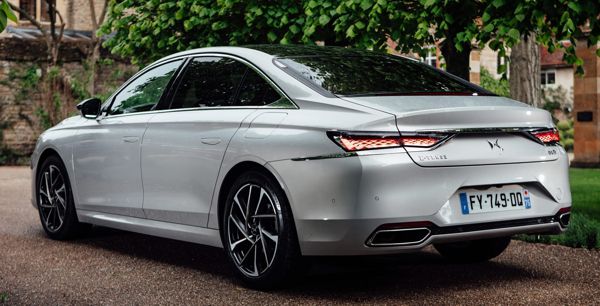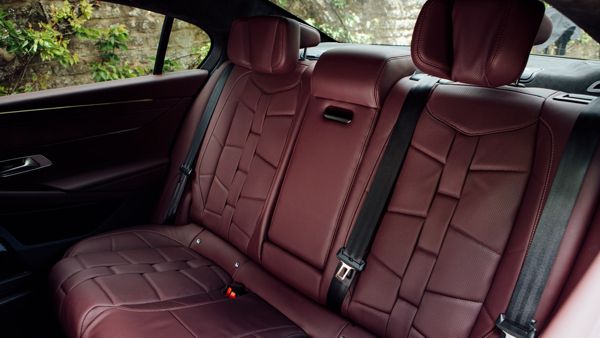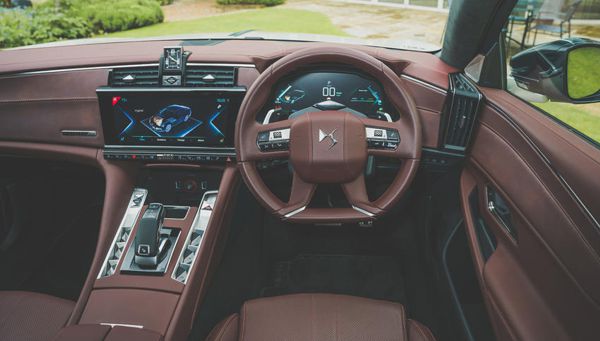Published
on 20
Sep 2021
|
All rights reserved.
|
|
|

|
|
The
return of French luxury, with the help of Chinese.
|
|
French large luxury cars
were loved for their unique style and superb suspension. However, since
Citroen C6, Peugeot 607 and Renault Vel Satis retired over a decade
ago, French car makers no longer produce any large luxury cars. So
embarrassing that the current French president has to settle with a DS7
Crossback, hardly a graceful choice. Now Citroen – okay, officially
speaking DS – finally resurrects French luxury motoring. Well, not
tailor-made for the French president, but more for the consumption of
Chinese companies and executives. The new DS9 is built exclusively in
Shenzhen, China, in the joint-venture plant owned 50:50 by PSA and
Baoneng group. It exports to European market, too, but not expected in
big numbers.
This is an E-segment car, measuring 4934 mm in length, 1855 mm in width
and runs a 2895 mm wheelbase, or about the size of BMW 5-Series. You
might ask, how can PSA group afford to build a dedicated platform for
it? Good question. In fact, the DS9 is built on the front-wheel-drive
EMP2 platform. EMP2 underpins the group’s C-segment cars like Peugeot
308 and D-segment cars like Peugeot 508 and DS7 Crossback. Stretching
to DS9 is certainly a challenge. The company has some solutions, but
bear in mind that no solutions can solve all problems.
The most notable is power unit. PSA has no 6-cylinder engines in its
arsenal. The best engine it can offer is Puretech 1.6 turbo, good for
only 225 horsepower, and it sounds coarse when working hard. The DS9
employs it in the base model, which does 0-60 in 7.6 seconds. For
comparison, BMW 530i employs a 2-liter turbo with 252 hp, good for 0-60
in 5.9 seconds and feels less stressed in acceleration. Likewise, the
Aisin 8-speed automatic employed by PSA group is no where near the ZF
8-speeder used by its German counterparts for smoothness, response and
consistency.

|
|
Taillights
with diamond patterns are one of the stylish touches.
|
|
PSA’s solution is electrification. The mid-range model E-tense 225
combines that Puretech 1.6 turbo engine – but detuned to 180 hp to make
it less noisy – and a 109 hp electric motor that sits between the
engine and gearbox. The combined output is again 225 hp, but torque
improves from 221 to 265 lbft, while refinement is higher, especially
in EV mode. The plug-in hybrid car uses a 11.9 kWh battery placed under
the rear seat that gives a theoretical range of 50km, although in
reality it is closer to 35km. The point is, it lowers CO2 emission
massively to just 33 grams each kilometer, qualifying for lower company
car taxes in some markets. Unfortunately, the plug-in hybrid components
add an extra 300kg, so the car is no quicker than the petrol base
model. In fact, 0-60 mph is slightly slower at 7.8 seconds.
If all these sound familiar, it is because the plug-in hybrid
powertrain comes straight from Peugeot 508 Hybrid. The same goes for
the range-topping E-tense 360, which mirrors the powertrain of 508 PSE.
Interestingly, this car is not built entirely in China. Based on the
lesser hybrid, it leaves the Shenzhen factory with a higher tuned,
200hp version of the petrol engine and larger front brakes, then ships
to the Poissy factory in France, where an electric rear axle is added.
That gives it another 113 horsepower, lifting the combined output to
360 hp and 383 lbft while adding 4-wheel-drive functionality. The car
is good for 0-60 mph in an estimated 5.3 seconds and tops a regulated
155 mph. Still slower than a six-cylinder 5-Series though, because it
weighs over 1900 kg.

|
|
Plenty
of legroom at the back, where many owners will spend time at.
|
|
The DS9 rides on multi-link suspensions at the back, but up front is a
pair of MacPherson struts, a popular arrangement for front-wheel-drive
cars (as it allows more space for the transverse powertrain to fit),
but it is not going to deliver the kind of roadholding and isolation of
rear-drive rivals that employ double-wishbones or multi-link front
axles. As a result, the DS9 is not a car to hustle through corners. Its
steering is linear and well weighted but lacks feedback. Its nose will
wash wide when entering a corner too quickly. Front-end grip and body
control are reasonable rather than remarkable. The brakes have a soft
pedal feel. There are 4 driving modes: Economy, Sport, Electric and
Hybrid, but even Sport fails to change its civilized manner too much.
However, the soft suspension delivers an absorbent ride. Save the
entry-level petrol model, the DS9 is standard fitted with road-scanning
adaptive damping, which uses an infrared camera at the windscreen
scanning the road ahead to adjust suspension stiffness. It is not quite
as magic carpet as the old hydractive suspension, but it still takes
care of low-speed bumps and potholes etc. admirably. Refinement is also
remarkable. When driven normally in Comfort mode, mechanical noise is
remarkably low. The petrol motor slips into the background. Wind and
tire noises are well insulated from the cabin, thanks partly to the use
of laminated side glass.
But buying decisions will be hinged on its style and build quality.
Outside, the DS9 certainly has its own character and sufficient road
presence. The body profile is long and extremely sleek, perhaps not as
unique as the late C6, but it is decorated with plenty of unique design
elements, such as the chrome stripe running in the middle of its
bonnet, the tasteful front grille, the thin LED signal lights and
wing-shape taillights with diamond patterns.
 |
|
Dynamically
and ergonomically fall short of rivals, but it feels luxurious and
comfortable.
|
|
Better still is the interior, which feels luxurious and high on style.
The cocooning environment is extensively trimmed with Nappa leather and
Alcantara. The speaker grilles are stainless steel. The leather
steering wheel is nice to touch. The leather seats front and rear are
finished in classy watchstrap patterns. Not only comfy, they are
heated, cooled and massaging. The center console features an analogue
clock which can be rotated and hidden out of sight, an idea inspired by
Bentley. The transmission tunnel has two rows of metal switches and a
classy shifter arranged in high style. It all looks and smells like
French luxury goods, despite its Chinese production site. The only
weakness is ergonomics. The 12-inch infotainment touchscreen might look
large but it displays small navigation map due to its wide aspect
ratio. The touchbar beneath the screen is a bit laggy. The window
switches are grouped into the transmission tunnel rather than located
logically at the doors, something chasing style over functions. There
are also no physical controls for air-con and audio, so you need to tap
into the touchscreen menus for adjusting temperature or volume.
On the plus side, the DS9 offers plenty of space for both rows of
occupants. Rear legroom is generous, while headroom is fine despite the
sleek roof line. Many DS9 will serve as company fleets in China. To
that end, its rear bench has a central armrest that incorporates
controls for lighting and massaging as well as USB ports and storage
space.
Like Lexus ES or Buick LaCrosse, the DS9 is priced to undercut the
established German executive cars yet offers more luxurious features as
standard. Dynamically and ergonomically, it is no match for its rivals.
However, if all
you chase is comfort and a unique style, the French luxury could be
tempting.
|
Verdict:    |
|